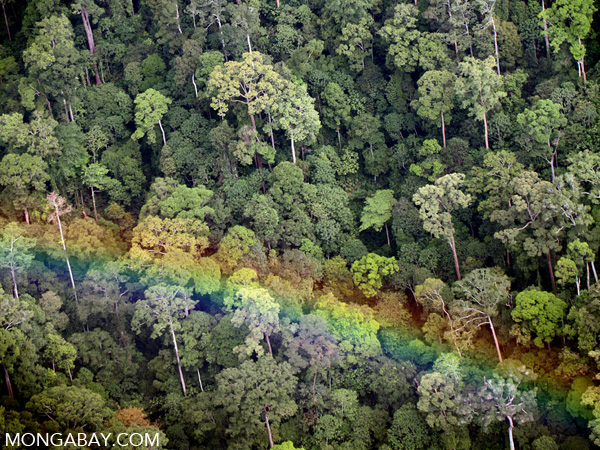Conservation compliance programs could reduce forest loss worldwide

Old-growth rainforest in Malaysian Borneo. Photo by Rhett A. Butler
Today, conservation compliance is a U.S. policy between governments and farmers that reward farmers with federal subsidies for good conservation practices on designated vulnerable lands. But economist Clayton Ogg believes it could now be used to save forests in countries like Brazil, China, India, and Indonesia.
“The main drivers for deforestation in recent years are high crop prices. However, as crop prices fall to more normal levels, farmers depend very heavily on government subsidies, and the subsidies become the major driver for deforestation,” Ogg told mongabay.com.
In a new paper in the Journal of Soil and Water Conservation, Ogg argues that bringing conservation compliance programs to new countries could turn subsidies into forest savers rather than destroyers.
Conservation compliance programs have been successfully employed in the U.S. for nearly 30 years. In 1985, the U.S. Farm Bill gave farmers the incentive to prevent 295 million tons of soil per year from eroding into the water system, and to protect 1.5 to 3.3 million acres of wetlands from being drained. Such impressive results have raised the question if similar programs could be a model for other countries struggling to preserve forests.
Conservation compliance programs could be supported in China, where farmers receive substantial government subsidies. Photo of a farmer and child taken in Tibetan Yunnan, (southern China) by Rhett A. Butler, mongabay.com.
The time is ripe now, according to Ogg, since crop prices have dropped “to levels less than half of what they had been for much of the previous ten years.”
“In the past three or four years, farm subsidies in Brazil, Indonesia, China, and India are now several times larger than past subsidies…For the first time, conservation compliance programs in the emerging agricultural countries offer a very exciting opportunity for reducing deforestation, as low crop prices converge with large, new subsidies to create an important conservation compliance opportunity,” Ogg noted.
Ogg, who has worked for the USDA and the U.S. Environmental Protection Agency, brings up a number of opportunities and challenges specific to emerging agricultural powers including China, India, Brazil, Indonesia, and Central Africa in the paper.

All of these countries experience high rates of deforestation, mostly due to agricultural expansion.
For example, Ogg suggested that compliance programs could be beneficial for countries like China and India, where deforestation is in the late stage. China currently offers substantial subsidies to individual farmers that could feasibly support conservation compliance programs.
“China’s farm subsidy payment system is very much like subsidies offered for decades in the U.S., so it could work like our Swampbuster Program,” noted Ogg. “If farmers destroy a forest or ecosystem and get caught by local officials, they lose eligibility for price support payments, government loans, or other subsidies.”
Given that China’s most salient conservation issues are related to agricultural expansion– such as desertification, soil quality, and water pollution–compliance programs could provide much-needed relief.
India could also benefit from compliance programs, but only if the government offered payments directly to farmers, as China does.
“India’s farm programs support crop prices, without offering farmers a payment. There apparently is no leverage for a conservation compliance program,” said Ogg. “Creation of conservation compliance could become part efforts to reform price support programs and fertilizer subsidies in India, both of which are criticized as inefficient and trade distorting, as well as environmentally damaging.”
Since Brazil, Indonesia, and Central Africa are in the early stages of deforestation, Ogg recommended that compliance programs complement conservation programs rather than replace them entirely.

Deforestation in Indonesia. Photo by Rhett Butler.
“Unlike India, some of Indonesia’s fertilizer is sold at a market price that exceeds the price of government subsidized fertilizer, making it much easier to establish conservation compliance,” Ogg said. “Since Indonesia heavily subsidizes fertilizer, its fertilizer subsidy offers potentially large conservation compliance leverage. Farmers of all sizes who destroy forests would lose their right to the subsidized fertilizer price. Ideally, this would be accomplished by providing farmers coupons for the subsidized fertilizer, which would be denied to farmers who do not comply. Indonesia also offers modest amounts of subsidized credit, which goes almost entirely to large farmers.”
Brazil is already ahead of the game, according to Ogg, as it has significantly slowed deforestation during the past ten years when crop prices were high.
“Hopefully, the opportunity to benefit farmers and to reduce deforestation will lead Brazil to adopt conservation compliance for its new price support programs and to expand the protections under Brazil’s credit conservation compliance program so that it protects more forests and savannas and to covers small farmers, as well as large farmers,” he said.
Ogg concluded that more research should be done investigating the link between conservation, crop price increases, and farm income benefits. Although every country has different conservation needs, Ogg said that understanding opportunities and challenges specific to emerging agricultural powers will benefit both farmers and the environment on a global scale.

Arial view of agriculture in the Amazon, Brazil. Photo by Sue Wren.
“There are tremendous opportunities for turning a major driver for deforestation (government payments to farmers during a period of lower, more normal crop prices) into a very powerful deterrent (conservation compliance) to prevent deforestation. Farmers all over the world have a very large interest in supporting strong conservation compliance measures because the government payments otherwise will undermine their own farm income supporting objectives, as they cause a lot more deforestation than would otherwise occur,” he noted.
Citations:
- Moseley, J. 2013. Conservation Compliance: A 25-Year Legacy of Stewardship. American Farmland Trust 2013.
- Hosonuma, N., M. Herold, V. De Sy, R. De Fries, M. Brockhaus, L. Verchot, A. Angelsen, and E. Romijin. 2012. An assessment of deforestation and forest degradation drivers in developing countries. Environmental Research Letters 7: 044009.